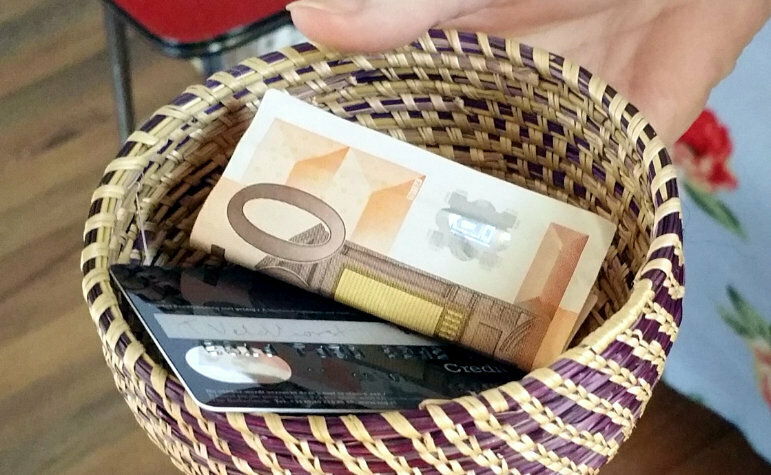
Insights & Opinions
What our bags, wallets and pockets can tell us about consumers’ changing financial behaviour
Thu, 11 Feb 2021


Consumers’ financial practices are set to change substantially over the coming decades due to the proliferation of products and providers in this space. While many people still depend heavily on banks for most of their transactions, they are beginning to experiment–and are growing bolder.
These changes make consumer behaviour difficult to predict. We cannot readily foresee how consumers will respond to increased choice in payments tools, which service providers will come to dominate the market, or how society will be affected as cash disappears.
Qualitative methods can help improve our predictions because they can shine a light on emerging behaviour. They are especially useful for investigating long tails because they can be adapted to explore topics not well understood by researchers, and can incorporate techniques to uncover insights into human behaviour that people themselves find difficult to articulate or understand.
In our research on mobile payments in the Netherlands, we used an innovative interview method called the ‘portable kit study’ that involved asking people to take everything out of their bags and wallets and talk us through what they carry with them on a daily basis. We especially focus on financial items: bank cards, mobile apps, receipts, store cards, and more.
Our intent was not to understand normative trends; in fact, it was the opposite. We wanted to uncover unusual stories, use cases, and values, in an attempt to spot potential future trends in behaviour and money culture. What we found often went against common wisdom, especially concerning people’s attitudes to different financial tools.
Why do the Dutch still carry cash?
Cash usage in the Netherlands has dropped steadily in recent years, with the preference for cash dropping from 32% in 2013 to 28% in 2016 (see Jonker et al. 2017). Many retail outlets, including restaurants and some parking meters, do not accept credit cards at all; others accept only credit cards from certain countries. An increasing number of shops (usually supermarkets and convenience stores) do not accept cash at all.
The Dutch debit card, therefore, acts like a financial ‘passport’: without it, consumers can find themselves undertaking complicated procedures to make payments—or leaving their groceries unpurchased at the point of sale.
Why, then, do the Dutch still carry cash?
We asked our participants, “How much money do you carry with you on a daily basis?” On the whole, they carried very little cash, with amounts ranging from EUR 0-40. They tended to withdraw cash from an ATM once every week or two. Cases in which participants carried cash because it was the only way to pay for a service included some market stalls, sporting activities, festivals, giving money to people on the street, and tattoo shops.
On interviewee, a graphic designer in her thirties reported that she still carries cash but rarely actually uses it. She told us that she keeps at least EUR 10 in her wallet because she knows there are places where you can’t use a debit card. However, at the time of the interview, she had been carrying EUR 35 in her wallet for at least three months and expects that it will stay there for a few months more. She told us, “If I can use the bank card, I will.”
For the most part, people carried cash for a sense of security rather than out of need. Another interviewee told us that she would usually carry around EUR 50 in her wallet because “you never know what will happen”. Two months ago, her partner was sick and needed a taxi to go to the doctor. She gave him cash to pay for the ride because she didn’t know if taxis accepted debit cards as she had never paid for one this way.
Cash as ‘free money’
Research suggests that it’s easier to overspend using a credit or debit card than with cash. The theory is that cash is more tangible and visible, and this makes it easier for people to track their spending. In contrast, payments made with cards tend to be invisible: people often swipe their cards without paying too much attention to the amount they are being charged.
However, not all of our participants viewed cards as encouraging spending. To our surprise, one interviewee, a female in her early forties, said used to spend more responsibly with cash but now she’s prone to spend it as she sees it as not “real money”. When she used to work in bars, she was paid in cash and she was very aware of how she managed it. When she got a ‘real job’ and her salary was paid into her bank account directly she began keeping around EUR 20-30 in her wallet as a ‘slush fund’ for things like coffee or other small purchases. Now she sees cash as ‘play money’:
Participant 1: If I have cash in my wallet, it’s like it’s not real money. It just goes.
Interviewer: Right, so that’s a motivating factor for you not carrying cash?
Participant 1: Yep. If I’ve got cash in my wallet, I’ll spend it.
Interviewer: What is it about the cash that makes you spend it?
Participant 1: Dunno, it’s like it’s not real money. It’s–it sounds weird. If money is in my account, and I’m paying through the card, I’m like mentally aware of what is going out and I’ve got an app on my phone so I can check my bank balance and so on and so forth, and I can pay via my phone, and it’s fine. But when there’s cash, it’s basically–if it’s in your wallet, it’s already spent … So, it’s been, it’s spent, I’ve already taken that into consideration in my monthly life, and then all of a sudden some money’s come back to me and I’m like, ooh! Off to the art shop I go.
In other words, if cash isn’t stored digitally, it is difficult to account for–and by extension, it doesn’t need to be accounted for.
We found a general preference among our interviewees for accounting digitally rather than in cash. With the advent of online banking and easy-to-use banking apps, most of our interviewees reported that they found it easier to track their spending digitally. They would log into their banking apps on their phones many times each day to check purchases made and the account balance. This had the effect of reversing their psychological relationship to cash.
From cash to choice
The shift from cash to digital financial management is virtually complete in the Netherlands as few payments are made in cash. However, the fact that almost everyone uses digital financial tools doesn’t mean that they are all use them to the same degree, or in the same ways.
When assessing consumer adoption of financial services we should pay attention not only to how many people have shifted to digital financial services, or even which digital features they are using, but also the very wide range of ways in which people try to adjust to this new digital financial world.
References
Arango-Arango, C.A., Bouhdaoui, Y., Bounie, D., Eschelbach, M. and Hernandez, L. 2018. Cash remains top-of-wallet! International evidence from payment diaries. Economic Modelling 69: 38-48.
Esselink, H. and Hernández, L., 2017. The use of cash by households in the euro area. ECB Occasional Paper (201).
Feinberg, R.A., 1986. Credit cards as spending facilitating stimuli: A conditioning interpretation. Journal of Consumer Research 13(3): 348-356.
Ho, S.S. and Ng, V.T., 1994. Customers′ risk perceptions of electronic payment systems. International Journal of Bank Marketing 12(8): 26-38.
Holmes, D.R., 2013. Economy of Words: Communicative Imperatives in Central Banks. Chicago: University of Chicago Press.
Jonker, N., Hernandez, L., de Vree, R. and Zwaan, P. 2017. From cash to cards: How debit card payments overtook cash in the Netherlands. Amsterdam: Netherlands Central Bank, Research Department.
Jonker, N., Kosse, A. and Hernández, L. 2012. Cash usage in the Netherlands: How much, where, when, who and whenever one wants? (No. 1002). Amsterdam: Netherlands Central Bank, Research Department.
Kamleitner, B. and Erki, B. 2013. Payment method and perceptions of ownership. Marketing Letters24(1): 57-69.
Khan, J., Belk, R.W. and Craig-Lees, M. 2015. Measuring consumer perceptions of payment mode. Journal of Economic Psychology 47: 34-49.
Maurer, B., 2006. The anthropology of money. Annual Review of Anthropology 35: 15-36.
Mesfin, W.M. 2014. Mobile Money Information System Architecture for Open Air Market in Ethiopia. IMTFI, http :// www . imtfi . uci . edu / files / docs /2014/ mobiles _ in _ open _ air _ market _ report . pdf
Moore, A. and Taylor, M., 2011. Time to cut up those debit cards? Effect of payment mode on willingness to spend. Journal of Consumer Policy 34(4): 415-422.
Penz, E. and Sinkovics, R.R. 2013. Triangulating consumers' perceptions of payment systems by using social representations theory: A multi‐method approach. Journal of Consumer Behaviour 12(4): 293-306.
Runnemark, E., Hedman, J. and Xiao, X., 2015. Do consumers pay more using debit cards than cash?. Electronic Commerce Research and Applications 14(5): 285-291.
Taylor, E.B. Forthcoming. The human impact of financial innovation: Mobility, choice, and risk. In Salampasis, D. and A. Mention. Transformation Dynamics in FinTech: An Open Innovation Ecosystem Outlook. Book series: Open Innovation: Bridging Theory and Practice. World Scientific Publishing.
Taylor, E.B. 2018a. How do the Dutch actually pay? Part I. The Paypers, 12 June.
Taylor, E.B. 2018b. How do the Dutch actually pay? Part II. The Paypers, 13 June.
Taylor, E.B. 2017a. Consumer finance in a mobile age: Methods for researching changing user behaviour. EPIC: Perspectives: 197-215.
Taylor, E.B. 2017b. Money in a mobile age: Emerging trends in consumers’ financial practices. Community Development Investment Centre, Reserve Bank of San Francisco, Working Paper 2017-03.
Taylor, E.B. and G. Lynch. 2016. Consumer Finance Research Methods Toolkit. IMTFI, University of California Irvine.
Van der Cruijsen, C., Hernandez, L. and Jonker, N., 2017. In love with the debit card but still married to cash. Applied Economics 49(30): 2989-3004.
Zelizer, V.A. 1994. The Social Meaning of Money. New York: Basic Books.
Link to https://vimeo.com/247848206
Link to https://www.epicpeople.org/how-to-talk-money/
Link to https://www.bundesbank.de/resource/blob/854150/d1d39a406c961cedcf980de42ae6b806/mL/cash-in-the-age-of-payment-diversity-data.pdf
Link to https://www.econstor.eu/bitstream/10419/168371/1/Jonker-et-al.pdf
Link to https://www.forbes.com/sites/billhardekopf/2018/07/16/do-people-really-spend-more-with-credit-cards/



